Scania Marine engine. DI16 EMS with S6/PDE. Operator’s manual - part 3
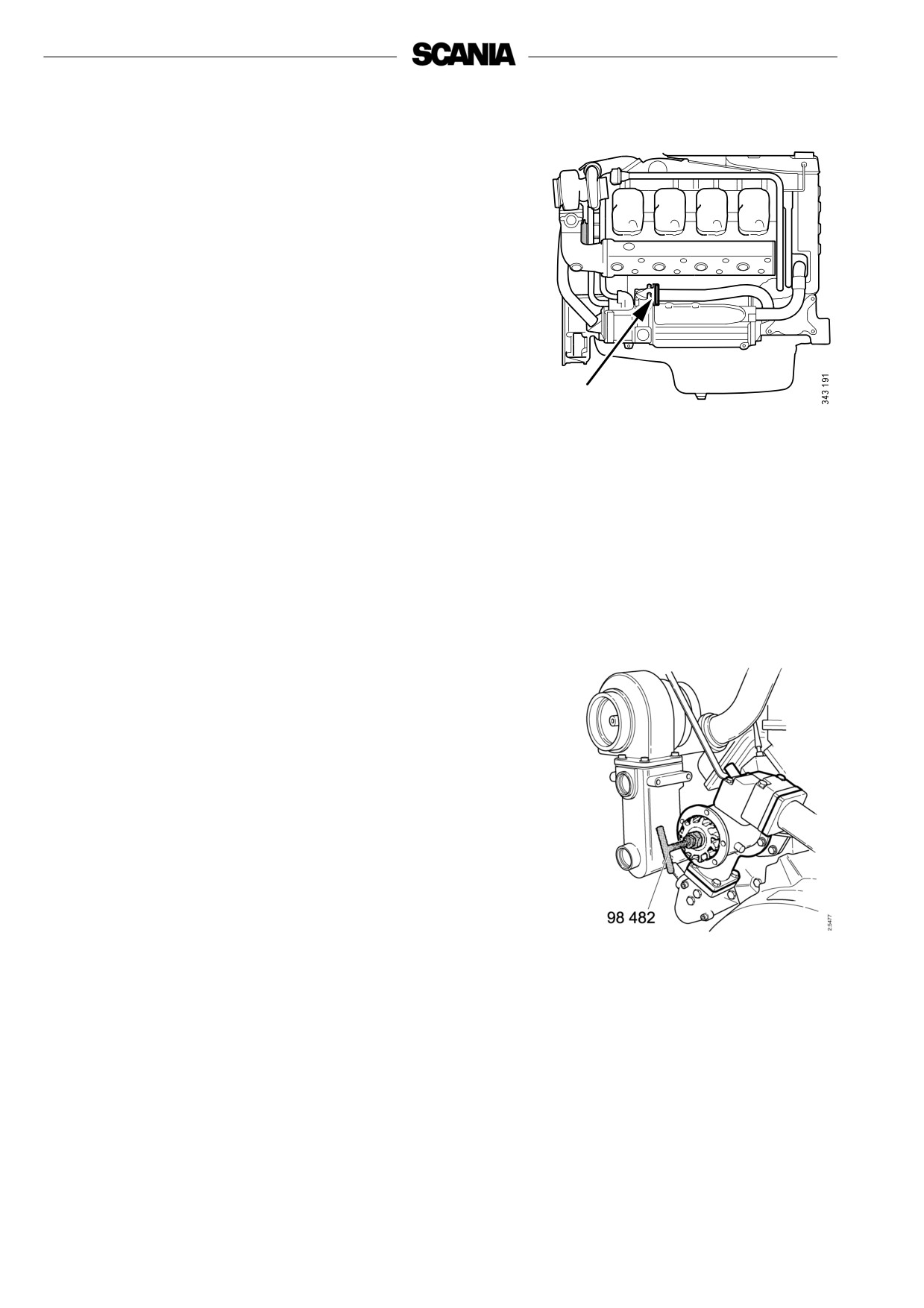
6. Every 400 hours:
Checking the sacrificial anodes
(Only engines with heat exchanger)
- Empty the sea water circuit and check the sacrificial anodes. There
are 2 of these, positioned as shown.
- Scrape off all loose material on the sacrificial anode.
- Renew if less than half of the sacrificial anode is left.
A new sacrificial anode is 63 mm long with a diameter of 17 mm.
Note: If the sacrificial anodes are very corroded they need to be
checked more often, for example every 200 hours.
7. Every 400 hours:
Checking the sea water pump impeller
(Only engines with heat exchanger)
- Close the bottom valve if the sea water pump is below water level.
- Drain the sea water circuit.
- Take off the sea water pump cap.
- Check that the vanes of the impeller are not worn or damaged.
Note: If the impeller must be renewed frequently, the cleaning of the
sea water needs to be improved.
Renewing the impeller
- Pull out the impeller with puller 98 482 (Scania special tools).
- Fit a new impeller and cap. Check that the cap seal is not hard or
damaged.
Note: There should be a spare impeller on board.
- The impeller can be deformed during extended periods of inactivity.
Renew the impeller before starting or remove the impeller before longer
periods of stoppage. Also see "Preparations for storage".
32
8. Every 2,400 hours:
Checking the coolant
Coolant should be checked as follows:
a) Check the appearance of the coolant.
b) Coolant with glycol only: Check the glycol content.
Coolant composition:
c) Coolant containing only Scania Corrosion Inhibitor:
If there is a danger of freezing:
Check the corrosion inhibitor content.
min 30% glycol by volume
max 60% glycol by volume
The composition of the coolant is described in more detail under
If there is no danger of freezing:
"Starting and running".
8-12% by volume
a)
Scania Corrosion Inhibitor
Checking the appearance of the coolant
- Pour a small amount of coolant in a container, and check that the coolant
is pure and clear.
- If the coolant is contaminated or cloudy: consider changing the coolant
- Water for the coolant must be clean and free from contamination.
- Use drinking water with a pH of 6-9.
!
WARNING
b)
Ethylene glycol can
Checking the glycol content
be fatal if ingested.
If there is a danger of freezing, use only glycol as protection against corrosion
Avoid skin contact
in the coolant.
with glycol.
- Cooling systems with glycol should contain at least 30% glycol by
volume to provide acceptable protection against corrosion.
-
30% glycol by volume provides antifreeze protection down to -16°C. If
additional antifreeze protection is required, see the table on the next
page to help you calculate how much glycol you need.
The coolant should be
pre-mixed when it is poured
Scania recommends only nitrite-free antifreeze glycols with the following
supplier designations:
into the cooling system.
Never top up with only water or
BASF G48 or BASF D542
only glycol.
- Always add glycol if the glycol content drops below 30% by volume. A
glycol content above 60% by volume will not provide greater protection
against freezing.
- The table shows the temperature at which ice starts to form. The engine
will freeze and break at appreciably lower temperatures, see diagram.
!
- Ice forming in the coolant often causes malfunctioning without any risk
Important
of damage. The engine should not be subjected to heavy loads when ice
The recommended glycols must
starts to form.
not be mixed with glycol
Note: The coolant should be changed when the cooling system is
containing nitrite-based
cleaned: every 4,800 hours or at least every 5 years.
corrosion inhibitor.
Important! If a coolant filter is used in the cooling system it must not
Risk of a build-up of sludge and
contain an inhibitor.
reduced cooling capacity.
33
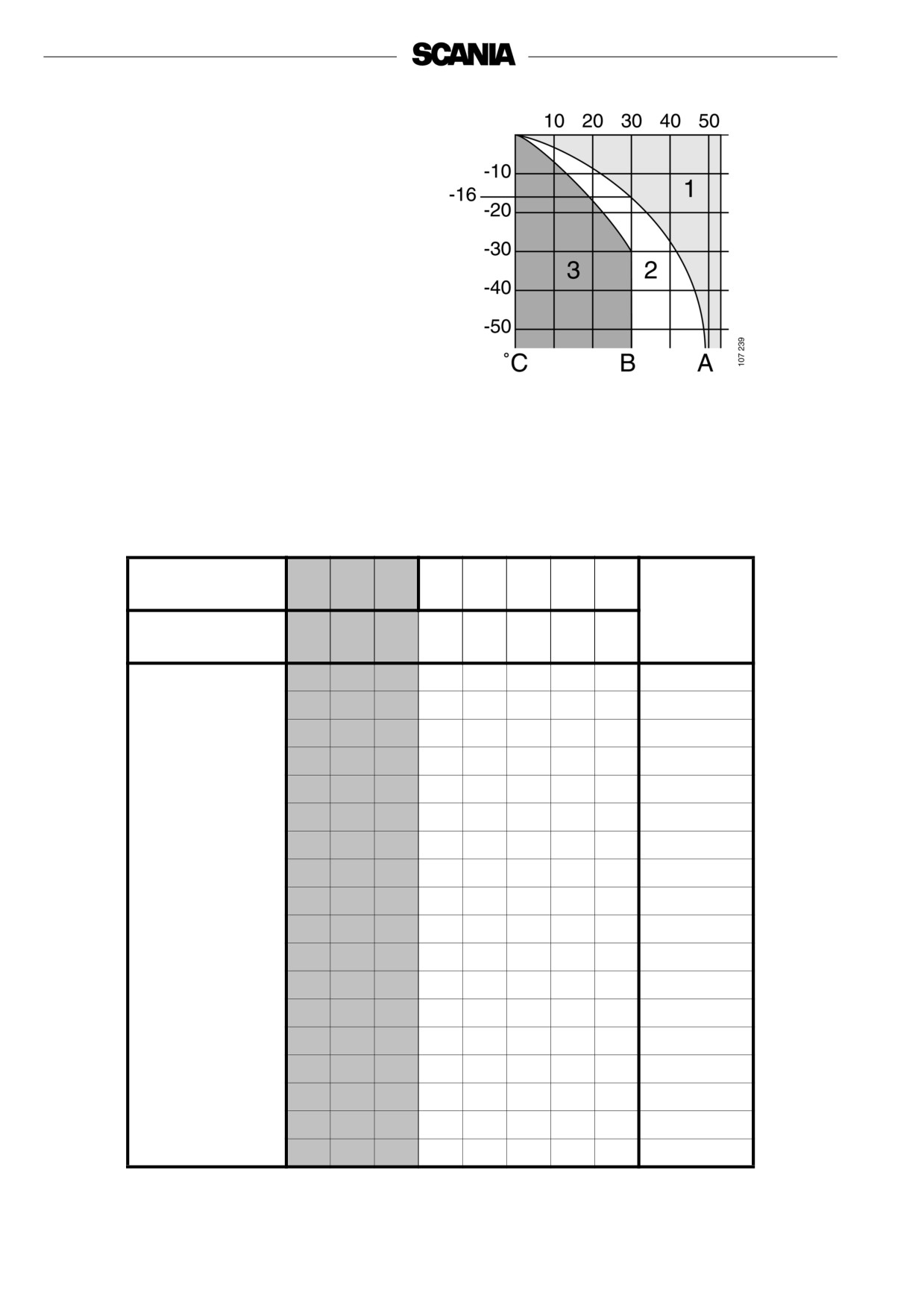
% by volume of antifreeze glycol
Characteristics of glycol at low temperatures:
- Example with 30% glycol by volume
- Ice slush starts to form at -16°C.
- There is a risk of malfunctions at -30°C
- No risk of damage by freezing with a
minimum content of 30% glycol by volume
Curve A: Ice formation starts (ice slush)
Curve B: Temperature at which there is a risk of damage by freezing
1.
Safe area
2.
Malfunctions may occur (ice slush)
3.
Risk of damage by freezing
A
% by volume of
Cooling
15
20
25
30
35
40
45
50
glycol
system
capacity,
Ice slush starts to
-6
-9
-12
-16
-21
-24
-30
-37
dm3
form at °C
5
6
8
9
11
12
14
15
30
6
8
10
12
14
16
18
20
40
8
10
13
15
18
20
23
25
50
9
12
15
18
21
24
27
30
60
11
14
18
21
25
28
32
35
70
12
16
20
24
28
32
36
40
80
14
18
23
27
32
36
41
45
90
15
20
25
30
35
40
45
50
100
Ethylene glycol
17
22
28
33
39
44
50
55
110
dm3 (litre)
18
24
30
36
42
48
54
60
120
20
26
33
39
46
52
59
65
130
21
28
35
42
49
56
63
70
140
23
30
38
45
53
60
68
75
150
24
32
40
48
56
64
72
80
160
26
34
43
51
60
68
77
85
170
27
36
45
54
63
72
81
90
180
29
38
48
57
67
76
86
95
190
30
40
50
60
70
80
90
100
200
A= Area to be avoided. Only for calculating glycol mix.
Coolant freezing point, when ice starts to form, for different glycol mixes
34
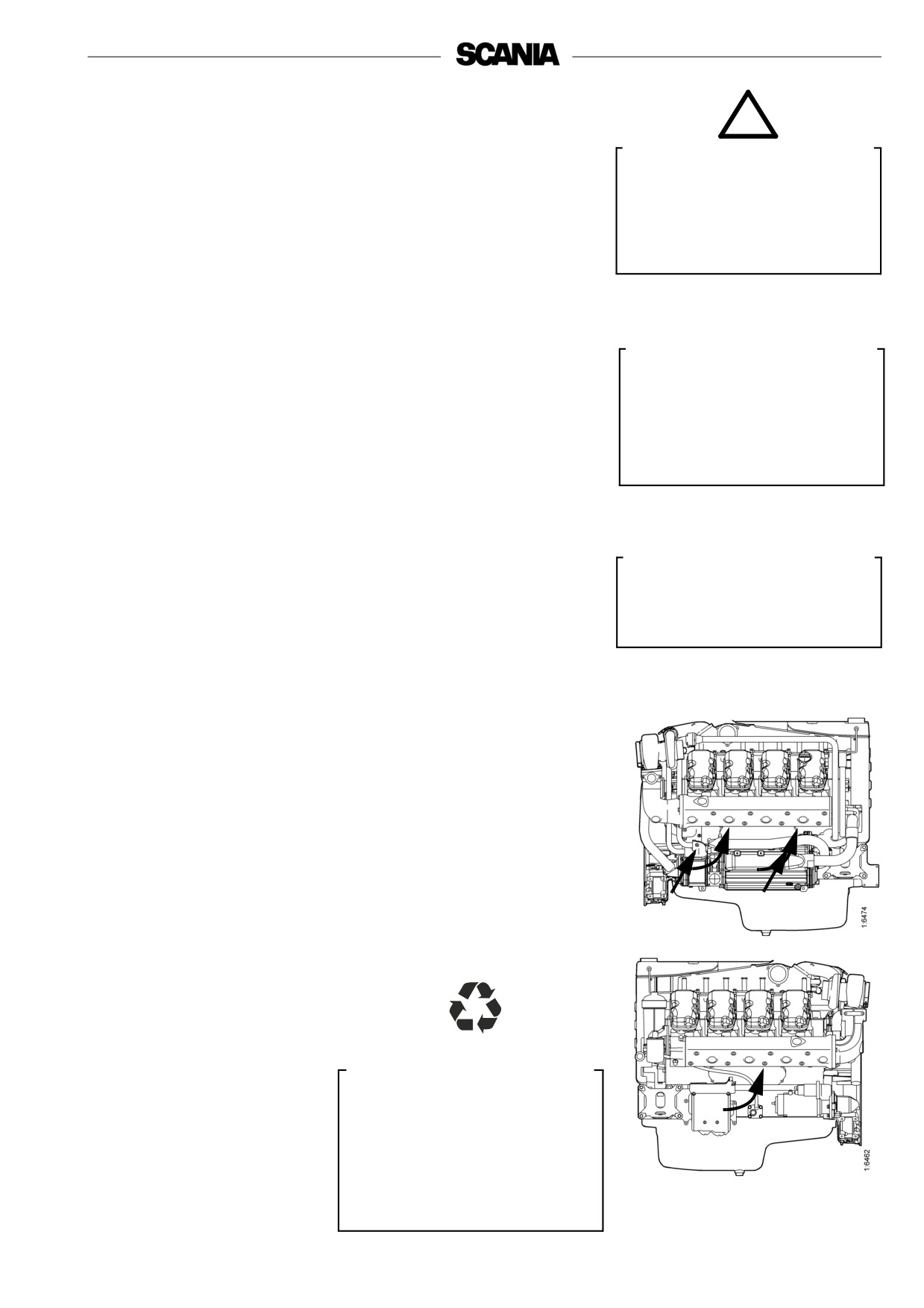
c)
!
Checking the corrosion inhibitor
WARNING
There must always be sufficient corrosion inhibitor in the coolant to protect
the cooling system against corrosion.
Corrosion inhibitor can be fatal
If there is no danger of freezing, only Scania Corrosion Inhibitor should be
if ingested.
used in the coolant.
Avoid contact with the skin.
The inhibitor in Scania Corrosion Inhibitor is free of nitrites.
The correct proportion of corrosion inhibitor is 8-12% by volume.
- Topping up with 1.0% Scania Corrosion Inhibitor by volume should be
!
done after every 2,400 hours of operation.
Important
- Never top up with water alone or corrosion inhibitor alone!
Fluid losses must always be replaced with pre-mixed coolant:
Mixing with glycol or the use of
water + 10% Scania Corrosion Inhibitor by volume.
too much corrosion inhibitor
can lead to a build-up of sludge
Note: The coolant should be changed when the cooling system is cleaned
every 4,800 hours or at least every 5 years.
and reduced cooling capacity.
!
Important
If a coolant filter has been fitted
it must not contain inhibitor.
Changing the coolant
1. Remove the filler cap from the expansion tank.
2. The coolant is drained at 3 points:
-
2 drain taps on the lower right-hand side of the block, see illustration
- Drain tap on the lower left-hand side of the block, see illustration.
And at the lowest point of the cooling system, remove 2 plugs under
the heat exchanger.
3. Close the drain taps.
4. Top up with coolant through the expansion tank's filler hole.
Mix coolant as described on page 33.
Help protect our
environment!
Use a container to avoid spills
when changing the coolant.
Dispose of used coolant through
an authorised waste disposal
contractor.
35
9. Every 4,800 hours:
Cleaning the cooling system
Note: If necessary, the cooling system should be cleaned more often.
External cleaning
Heat exchanger
1.
Drain the coolant from the engine and the heat exchanger, see
"Changing the coolant".
Help protect our
environment!
2.
Empty the sea water circuit and loosen the heat-exchanger sea water
inlet and outlet connections. Remove the radiator, where fitted, with
Use a container to avoid spills
pipe from the top of the heat exchanger.
when changing the coolant.
3.
Remove the pipes to and from the engine cooling system.
Dispose of used coolant through
4.
Remove the pipes to and from the charge air cooler.
an authorised waste disposal
contractor.
5.
Remove the entire heat exchanger unit.
6.
Unscrew the rear cover and remove the charge air cooler core with
O-rings.
7.
Remove the charge air cooler housing and the loose flange with O-rings.
!
8.
Unscrew the intermediate piece with the sea water outlet.
Important
9.
Unscrew the front cover and remove the loose flange with O-rings.
10.
Remove the cooler core for the main engine circuit.
The cooling system must never
be cleaned with caustic soda.
11.
Clean the outside of the cores. Use a paraffin-based engine cleaning
agent.
There is a risk of damage to
aluminium parts.
12.
Any internal deposits in the pipes can be removed mechanically using a
round rod.
13.
Lubricate all new O-rings.
14.
Fit a new O-ring inside the main core flange and push the core into the
housing.
15.
Fit new O-rings on the end of the core with a loose flange between.
16.
Fit the front cover and tighten the hexagon screws to 26 Nm.
17.
Fit a new O-ring in the intermediate piece and screw this onto the heat
exchanger, tightening to 26 Nm.
18.
Fit the small heat exchanger housing on the stud bolts.
19.
Fit a new O-ring inside the small core flange and push it into the
housing.
20.
Fit new O-rings on the end of the core with a loose flange between, and
push the housing with core fully up to the intermediate piece.
21.
Fit a new O-ring inside the small core flange and fit the rear cover.
Tighten the flange nuts to 26 Nm.
22.
Fit the complete heat exchanger to the engine and tighten the screws to
92 Nm.
23.
Connect the sea water pipes and the radiator where fitted. Connect the
pipes to the engine and charge air coolers.
36
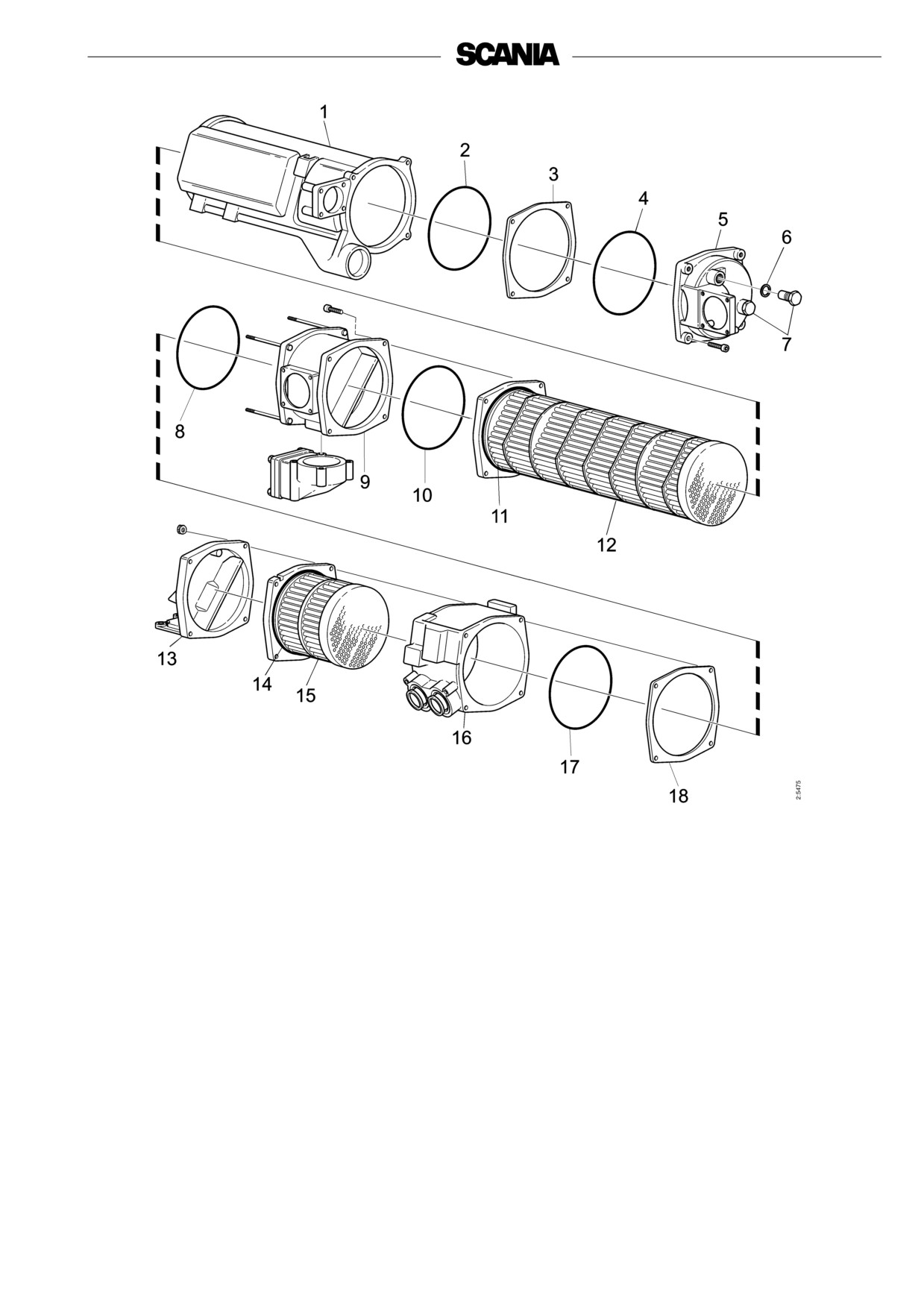
1. Heat exchanger housing, main
12. Core, main section
section
13. Rear cover
2. O-ring
14. O-ring
3. Flange
15. Core, charge air section
4. O-ring
16. Heat exchanger housing, charge
5. Front cover
air section
6. Seal
17. O-ring
7. Sacrificial anodes
18. Flange
8. O-ring
9. Housing, intermediate section
10. O-ring
11. O-ring
37

Charge air cooler
1.
Drain the coolant from the engine, see "Changing the coolant".
2.
Remove the catwalk, belt guard and expansion tank.
Help protect our
3.
Remove the air pipes from the turbochargers and the pipe between the
environment!
charge air coolers.
Use a container to avoid spills
4.
Release the pipe connections for the coolant inlet and outlet on the
when changing the coolant.
charge air coolers.
Dispose of used coolant through
5.
Remove the closed crankcase ventilation valve where fitted.
an authorised waste disposal
6.
Dismantle the charge air cooler according to the illustration.
contractor.
Take care not to damage the core's water connections.
7.
Clean the outside of the cooler core. Use a paraffin-based engine
cleaning agent.
8.
Fit a new gasket to the underside of the charge air cooler
9.
Screw the core into the lower part. Tighten the screws to 26 Nm.
10.
Fit the upper part of the charge air cooler. Tighten the screws to 50 Nm.
11.
Refit the pipe connections for the inlet and outlet of the charge air
coolers, and clamp the outlet pipe together with the thermostat housing
to the charge air cooler.
12.
Refit the air pipes from the turbochargers and the pipe between the
charge air coolers.
13.
Refit the expansion tank, catwalk and belt guard.
1. Intake manifold, upper part
2. Core
3. V-ring seal
4. O-ring
5. Pipe connection
6. Gasket
7. Intake manifold, lower part
38
Internal cleaning
Removing oil and grease
- If possible, run the engine until it has reached operating temperature and
then drain the cooling system.
Help protect our
- Remove the thermostats.
environment!
- Fill the system with clean, hot water mixed with liquid dishwasher
Use a container to avoid spills
detergent designed for household use.
when changing the coolant.
Concentration 1% (0.1/10 l).
Dispose of used coolant through
- Run the engine until warm for about 20-30 minutes. Remember the cab
an authorised waste disposal
heating system, if fitted.
contractor.
- Drain the cooling system.
- Fill the system again using clean, hot water and run the engine for about
20-30 minutes.
- Drain the water from the system.
!
- Refit the thermostats.
WARNING
- Top up the system with new coolant according to the specification on
When handling cooling system
page 33.
detergent:
read the warning text on the
Removing deposits
containers.
- If possible, run the engine until it has reached operating temperature and
then drain the cooling system.
- Remove the thermostats.
- Fill the system with clean, hot water mixed with some of the radiator
cleaning agent available on the market which is based on sulphamic acid
and contains dispersing agents. Follow the manufacturer's instructions
for the concentration and cleaning period.
- Run the engine for the specified time and then drain the cooling system.
- Refill the system with hot water and run the engine for about
20-30 minutes.
- Drain the water from the system.
- Refit the thermostats.
- Top up the system with new coolant according to the specification on
page 33.
39

Air cleaner
10. Daily:
Checking the read-out from the vacuum
indicator
If the indicator's red plunger is fully visible, renew or clean the air cleaner
filter element, see point 11. This is especially important if the engine is run
with a heavy load or high engine speed.
11. Every 1,200 hours:
!
Important
Cleaning or renewing the filter element
Only use genuine Scania air
Note: Earlier if the vacuum indicator shows red.
filters.
Dismantling
WARNING! Renew the filter
1. Remove the side cover from the air cleaner.
element if it is
damaged.
2. Renew or clean the element.
WARNING!
!
Note: Cleaning the element always entails a risk of damaging it. The
WARNING
element can only be cleaned a maximum of 4 times. After
cleaning it has a poorer
Never start the engine without
dust capacity than a new element.
the air filter.
There is a risk of injury or
3. Mark the filter when it has been cleaned.
serious engine damage.
Cleaning the element
- Carefully blow the filter element clean using dry compressed air from
the inside.
1
2
Note: This filter element must not be washed with water.
3
1. Cover
2. Filter element
3. Filter housing
40
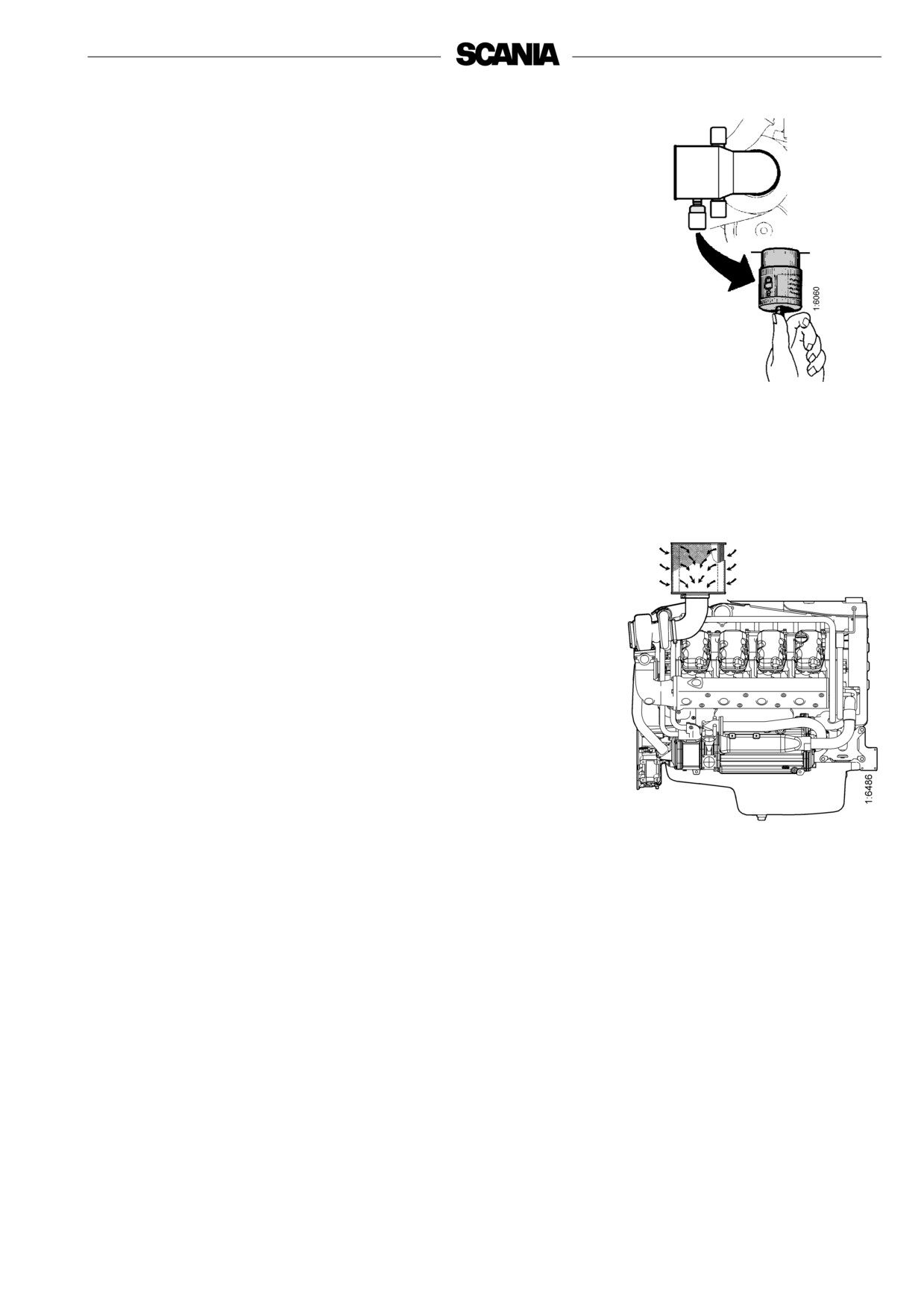
Checks
- Insert a torch into the element and check from the outside that there are
no holes or cracks in the filter paper.
- Renew the filter element if it has the slightest damage. Danger of engine
damage.
Assembly
1. Assemble the air cleaner in reverse order.
2. Reset the vacuum indicator by pressing the button.
Filter with a non-renewable element (unit cleaner)
Cleaning
- The filter may be cleaned a maximum of 3 times. Mark the filter after
each time it has been cleaned.
- Use a cleaning solution consisting of water mixed with approx. 1% mild
detergent.
1. Pour the cleaning solution into the element outlet at the same time as
turning the element so that the cleaning solution pours through the
element against the direction of the air flow.
2. Leave the element in the cleaning solution for 5 minutes and then take it
out so that all the cleaning solution drains away.
3. Rinse the filter with about 30 litres of clean water at 30-40°C. Pour the
rinsing water through the element in the same way as you did the
cleaning solution.
4. Take out the element and allow the rinsing water to drain off.
5. Repeat this procedure until the rinsing water is clean.
6. Leave the element to dry in a warm place for approximately 24 hours.
7. The filter must not be dried with compressed air.
41

Fuel system
!
12. Daily:
Important
Observe the utmost cleanliness
Checking the fuel level
when working on the fuel
- Top up with fuel if necessary. At the same time, drain the water
system.
separating filter.
There is a risk of engine
- If the tank has been run dry, bleed the fuel system, see point 13.
malfunction and damage to the
injection equipment.
13. Every 1,200 hours:
!
Renewing the fuel filter
Important
Fuel tanks
Use only genuine Scania fuel
- Drain any water from the fuel tanks.
filters.
Main filter
The filter consists of a filter unit.
- Wash the outside of the filter and unscrew it.
- Fit the new filter and tighten it by hand.
Never use tools for this. The filters can be damaged, obstructing
circulation.
- Bleed the fuel system according to the instructions overleaf.
- Start the engine and check for leaks.
Help protect our
environment!
Use a container to avoid spills
when bleeding and renewing
components.
42
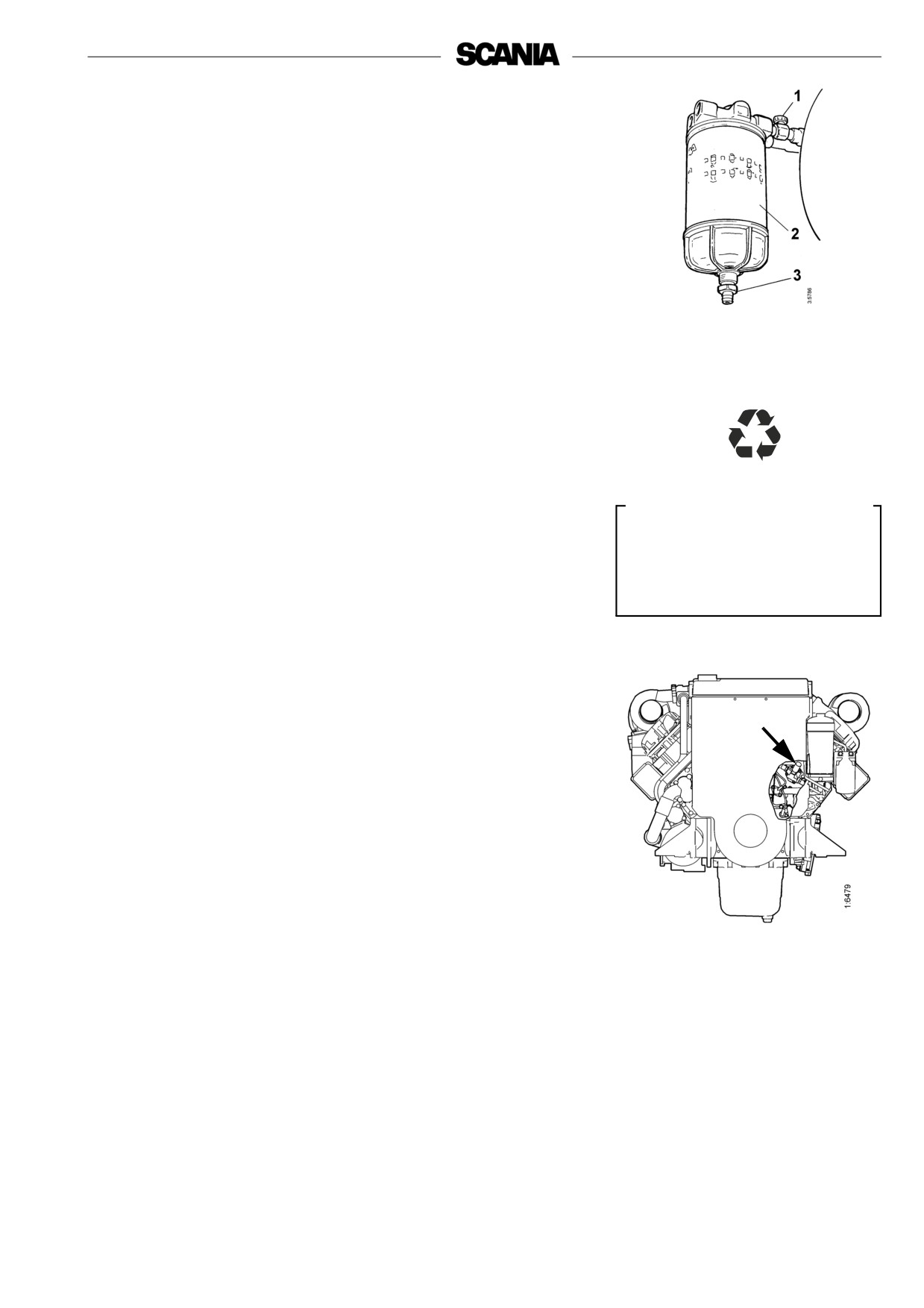
Water separating filter
- Drainage must be carried out when filling fuel.
- The filter must be renewed at the same renewal interval as the main
filter.
- Close the tap (1) before the filter.
- Unscrew the container and drain valve (3).
- Unscrew and renew the filter (2). Lubricate the seal before tightening
the new filter by hand.
- Screw the container and drain valve into position.
1. Shut-off cock
- Open the tap (1).
2. Filter
- Bleed the fuel system after renewing both filters.
3. Drain valve
Help protect our
environment!
Use a container to avoid spills
when bleeding and renewing
components.
Bleeding the fuel system
- Fit transparent plastic hoses on the bleed nipples of the fuel manifolds.
Run the hoses to a container to collect the fuel.
- Open the bleed nipples and pump the hand pump (1 until the fuel
flowing out of the nipples is free of air bubbles. This may take around
130-150 pump strokes.
- Close the bleed nipples and remove the hoses.
- Continue hand pumping until it feels tight.
• After renewing the fuel filter, it will take approximately 20 strokes.
• Approx. 50 pump strokes after renewing a unit injector.
- Start the engine and check for leaks.
Important! The starter motor may only be used for 30 seconds at a time.
After that time it must rest for 2 minutes.
If the engine fails to start after bleeding:
- Open the bleed nipples again and pump the hand pump until fuel
without air bubbles flows out.
- Tighten the bleed nipples. Start the engine and check for leaks.
43
Electrical system
!
14. Every 200 hours:
WARNING
Checking the electrolyte level in
Avoid naked flames or sparks
batteries
near the batteries.
When the batteries are charged,
1. Unscrew the plugs and check the electrolyte level in all cells.
oxyhydrogen gas is formed
2. Top up with distilled water until the level is 10-15 mm above the plates.
which is flammable and
explosive.
15. Every 1,200 hours:
Checking the state of charge in
batteries
!
WARNING
- Check the density with an acid tester.
In a fully-charged battery it should be:
Wear gloves and protective
goggles when charging and
1.280 at +20°C
handling batteries.
1.294 at 0°C
The batteries contain a highly
1.308 at -20°C
corrosive acid.
- If the density is below 1.20, the battery must be charged. A discharged
battery freezes at -5°C.
Do not boost charge the battery. This will damage the battery in the long
run.
!
WARNING
16. Every 1,200 hours:
Do not connect the terminals
Cleaning batteries
incorrectly.
This can cause serious damage
1. Clean batteries, electrical cables and cable terminals.
to the electrical system.
2. Check that all cable terminals are firmly tightened.
If the terminals are shorted,
3. Grease the battery terminals and cable terminals with Vaseline.
sparking will occur.
44
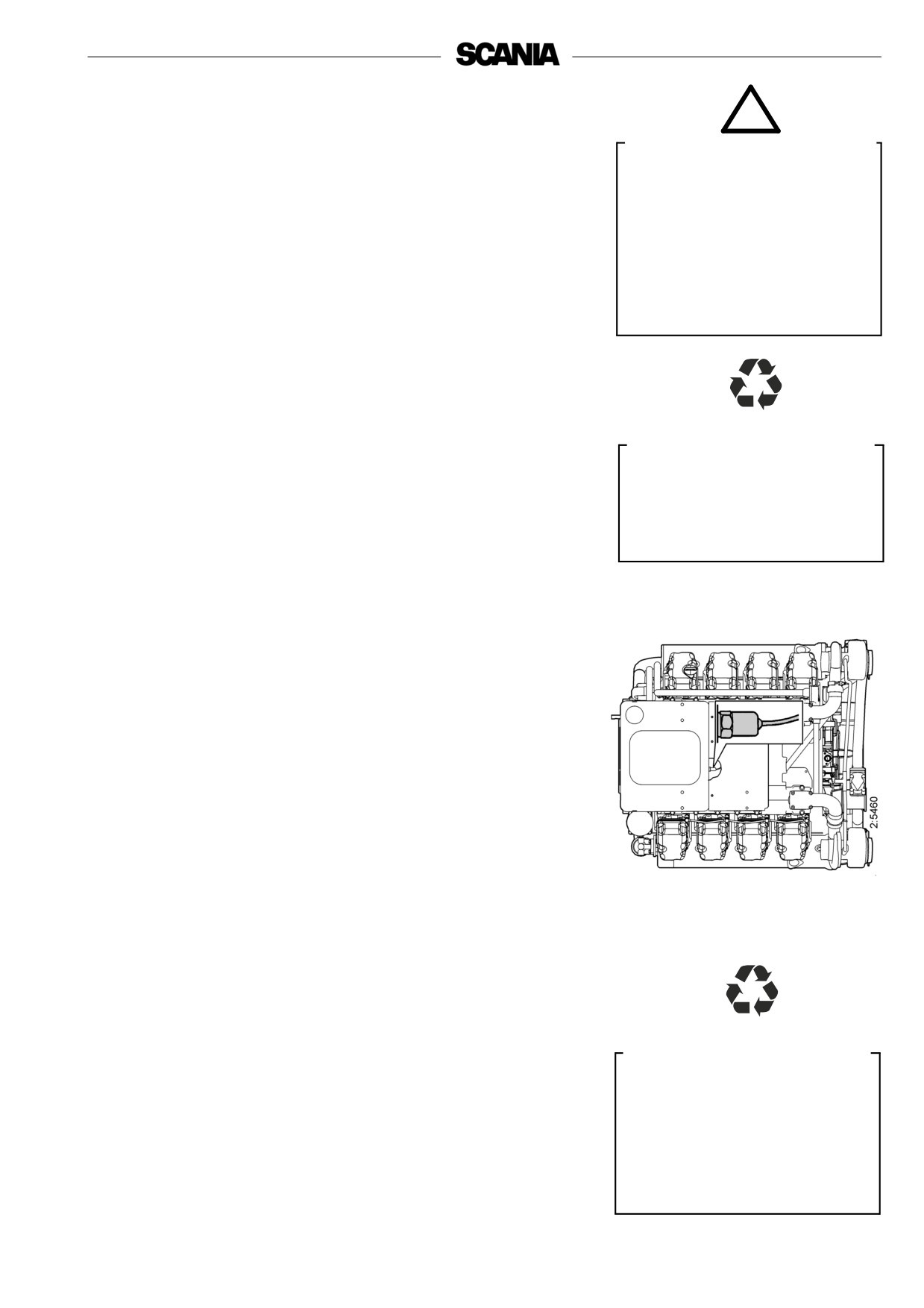
Renewing the battery
!
Removing
WARNING
1. Disconnect the negative cable (-) from the battery (electrical cable
Do not connect the terminals
connected to earth).
incorrectly.
2. Disconnect the positive cable (+) from the battery (electrical cable
This can cause serious damage
connected to starter motor).
to the electrical system.
Fitting
If the terminals are shorted,
1. Connect the positive cable (+) to the battery (electrical cable connected
sparking will occur.
to starter motor).
2. Connect the negative cable (-) to the battery (electrical cable connected
to earth).
Help protect our
environment!
Dispose of used batteries
through an authorised waste
disposal contractor.
17. Every 1,200 hours:
Checking the coolant level monitor
(Optional equipment)
1. Start the engine.
2. Reduce the coolant level in the expansion tank to below the level
monitor.
3. Automatic stop in the event of a fault: The engine stops, the indicator
lamp comes on and the buzzer (if fitted) sounds if there is no fault in
the level monitor. If the function is connected via the coordinator, the
emergency stop fault code will be generated and can be read off on the
Level indicator in expansion
diagnostics lamp.
tank
4. No automatic stop in the event of a fault: The indicator lamp comes
on and the buzzer (if fitted) sounds if there is no fault in the level
monitor.
5. Top up coolant to the correct level, see page 31.
Help protect our
environment!
Use a container to avoid spills
when draining the coolant.
Dispose of used coolant through
an authorised waste disposal
contractor.
45

Miscellaneous
1
18. Every 1,200 hours:
Checking the drive belt
- If the drive belt (1), which is a poly-V belt, is worn or damaged it must
be renewed.
- Also check that the automatic belt tensioner (2) is in proper working
order and keeps the drive belt correctly tensioned.
2
46
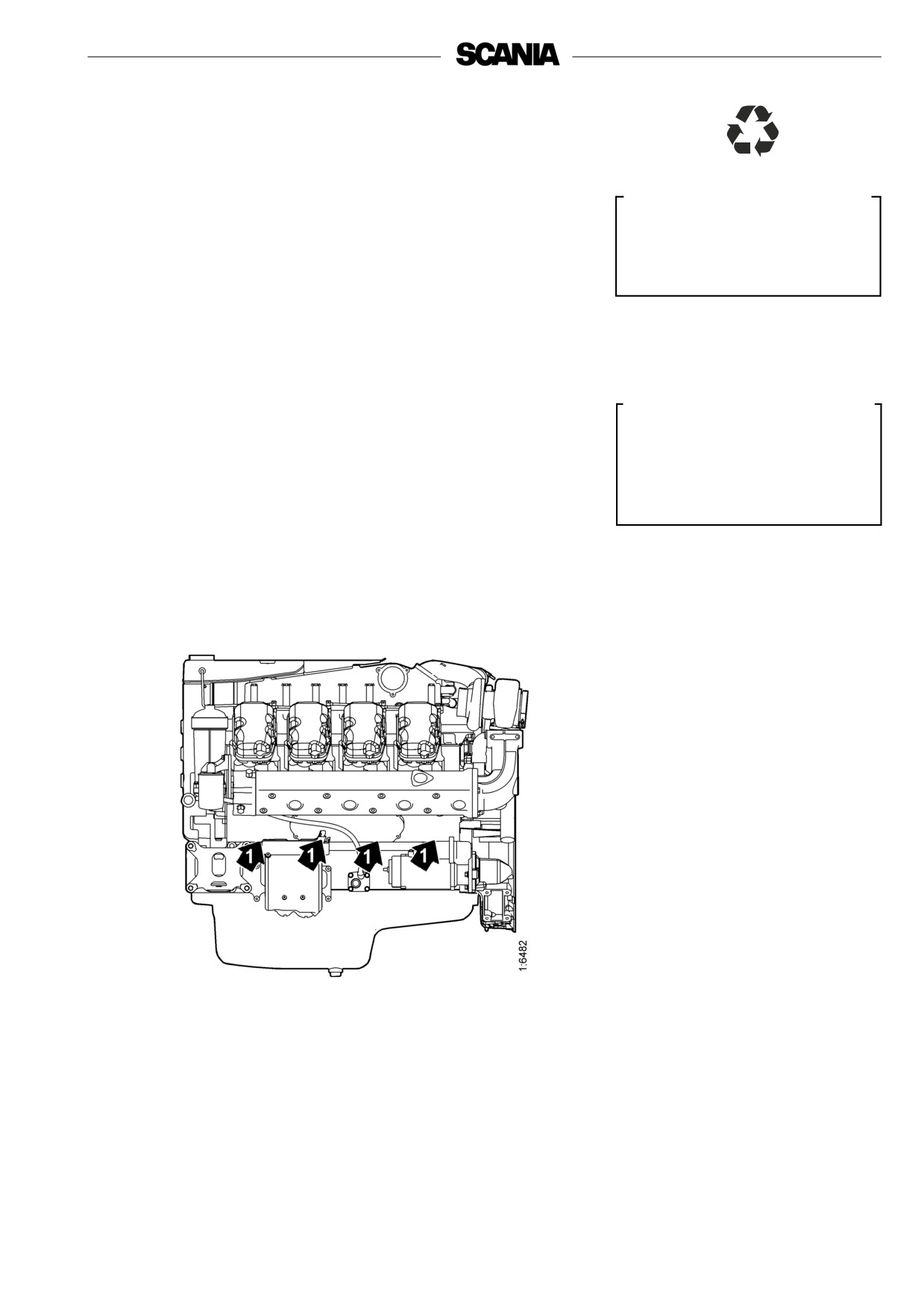
19. Daily:
Check for leaks, rectify as necessary
- Start the engine.
Help protect our
- Check for oil, coolant, fuel, air and exhaust leaks.
environment!
- Tighten or renew leaking connections. Check the overflow holes (1) in
Take care to ensure that any
the block which show whether the O-rings between the cylinder liners
leaks do not cause pollution.
and crankcase are leaking, see figure.
a) If coolant is running out, the O-ring is leaking.
b) If lubricating oil is running out, the liner shelf is leaking.
- Check that there are no leaks from the coolant pump. If there is a leak,
renew the pump seal or the complete coolant pump.
!
- A small amount of leakage from the overflow holes during the engine
Important
running-in period is normal. Sealing rings and O-rings are lubricated
with soap or oil when fitted.
If serious leakage occurs,
- This leakage normally stops after a time.
contact your nearest Scania
workshop.
47